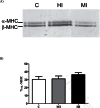Moderate intensity, but not high intensity, treadmill exercise training alters power output properties in myocardium from aged rats
- PMID: 22843668
- PMCID: PMC3636676
- DOI: 10.1093/gerona/gls146
Moderate intensity, but not high intensity, treadmill exercise training alters power output properties in myocardium from aged rats
Abstract
Aging is characterized by a progressive decline in cardiac function, but endurance exercise training has been shown to retard a number of deleterious effects of aging. However, underlying mechanisms by which exercise training improves age-related decrements in myocardial contractile function are not well understood. The purpose of this study was to determine the effects of exercise training on power output properties in permeablized (skinned) myocytes of old rats. Thirty-month-old rats were divided into sedentary control (C) and groups undergoing 11 weeks of treadmill exercise training at moderate intensity (MI) and at high intensity (HI). Peak power output normalized to maximal force was significantly increased in MI but not in HI compared to C with significant increases in atrial myosin light chain 1 in ventricle. These results suggest that MI exercise training is beneficial as a significant increase was seen in the ability of the myocardium to do work, but this effect was not seen with HI training.
Figures




Similar articles
-
Regional differences in effects of exercise training on contractile and biochemical properties of rat cardiac myocytes.J Appl Physiol (1985). 2003 Jul;95(1):35-42. doi: 10.1152/japplphysiol.00951.2002. Epub 2003 Jan 24. J Appl Physiol (1985). 2003. PMID: 12547843
-
Altered single cell force-velocity and power properties in exercise-trained rat myocardium.J Appl Physiol (1985). 2003 May;94(5):1941-8. doi: 10.1152/japplphysiol.00889.2002. Epub 2003 Jan 10. J Appl Physiol (1985). 2003. PMID: 12524379
-
Effect of aging on power output properties in rat skinned cardiac myocytes.J Gerontol A Biol Sci Med Sci. 2011 Dec;66(12):1267-73. doi: 10.1093/gerona/glr150. Epub 2011 Sep 5. J Gerontol A Biol Sci Med Sci. 2011. PMID: 21896503 Free PMC article.
-
High-intensity aerobic exercise training improves the heart in health and disease.J Cardiopulm Rehabil Prev. 2010 Jan-Feb;30(1):2-11. doi: 10.1097/HCR.0b013e3181c56b89. J Cardiopulm Rehabil Prev. 2010. PMID: 20040880 Review.
-
Aging skeletal muscle: response to exercise.Exerc Sport Sci Rev. 1994;22:91-120. Exerc Sport Sci Rev. 1994. PMID: 7925554 Review.
Cited by
-
A high-whey-protein diet does not enhance mechanical and structural remodeling of cardiac muscle in response to aerobic exercise in rats.Phys Act Nutr. 2022 Mar;26(1):28-38. doi: 10.20463/pan.2022.0005. Epub 2022 Mar 31. Phys Act Nutr. 2022. PMID: 35510443 Free PMC article.
-
Moderate-Intensity Exercise Improves Mesenteric Arterial Function in Male UC Davis Type-2 Diabetes Mellitus (UCD-T2DM) Rats: A Shift in the Relative Importance of Endothelium-Derived Relaxing Factors (EDRF).Biomedicines. 2023 Apr 8;11(4):1129. doi: 10.3390/biomedicines11041129. Biomedicines. 2023. PMID: 37189747 Free PMC article.
-
Interaction of genetic background and exercise training intensity on endothelial function in mouse aorta.Korean J Physiol Pharmacol. 2020 Jan;24(1):53-68. doi: 10.4196/kjpp.2020.24.1.53. Epub 2020 Dec 20. Korean J Physiol Pharmacol. 2020. PMID: 31908575 Free PMC article.
-
Force properties of skinned cardiac muscle following increasing volumes of aerobic exercise in rats.J Appl Physiol (1985). 2018 Aug 1;125(2):495-503. doi: 10.1152/japplphysiol.00631.2017. Epub 2018 May 3. J Appl Physiol (1985). 2018. PMID: 29722623 Free PMC article.
-
Effect of age and exercise on the viscoelastic properties of rat tail tendon.Ann Biomed Eng. 2013 Jun;41(6):1120-8. doi: 10.1007/s10439-013-0796-4. Epub 2013 Apr 3. Ann Biomed Eng. 2013. PMID: 23549897 Free PMC article.
References
-
- Renlund DG, Gerstenblith G. Exercise and the aging heart Cardiol Clin 1987;5(2):331 336 - PubMed
-
- Shephard RJ, Balady GJ. Exercise as cardiovascular therapy Circulation 1999;99(7):963 972 - PubMed
-
- Brenner DA, Apstein CS, Saupe KW. Exercise training attenuates age-associated diastolic dysfunction in rats Circulation 2001;104(2):221 226 - PubMed
-
- Taffet GE, Michael LA, Tate CA. Exercise training improves lusitropy by isoproterenol in papillary muscles from aged rats J Appl Physiol. 1996;81(4):1488 1494 - PubMed
-
- Tate CA, Taffet GE, Hudson EK, Blaylock SL, McBride RP, Michael LH. Enhanced calcium uptake of cardiac sarcoplasmic reticulum in exercise-trained old rats Am J Physiol Heart Circ Physiol. 1990;258(2):H431 H435 - PubMed
Publication types
MeSH terms
Substances
Grants and funding
LinkOut - more resources
Full Text Sources
Medical

